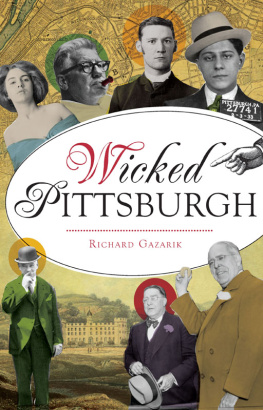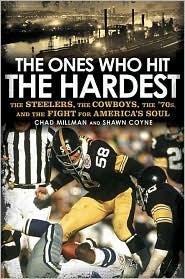Table of Contents
To Stacy, Zac, Owen, Bibb, Bleecker, Waverly, and Crosby.
They earned it.
I believe the game is designed to reward
the ones who hit the hardest.
If you cant take it, you shouldnt play.
JACK LAMBERT
PROLOGUE
ON FRIDAY, JANUARY 17, 1969, THE FORTY-TWO-YEAR-OLD COMMISSIONER of the National Football League checked into a Jacksonville hotel. Forewarned that a charismatic, game-changing quarterback was in town for an all-star football game, hotel security was doing its best to hold fans at bay. But the commissioner couldnt help but notice the bevy of young women in the hotels lobby and lounge, waiting expectantly for the star to make his entrance. This wasnt the kind of crowd Pete Rozelle was used to. Red-faced men in fedoras were more his speed. He settled into his suite, ordered a rusty nail and a bowl of nuts from room service and waited, just like the others, for the guy the kids were calling Broadway Joe.
Five days earlier, Joe Namath had led the New York Jets to victory over the Baltimore Colts in Super Bowl III. Rozelle had read William N. Wallaces column for
The New York Times the morning after the game:
Because of what Joe Namath accomplished in the Super Bowl yesterday, pro football will never quite be the same again... The reason for having such games, these Super Bowls, is so that once in a long while the impossible can happen... if it could never happen, the great talent of Joe Willie Namath would be pumping gas in Beaver Falls without rhyme or reason.
Namath won with deception, handing the ball off when the Colts expected pass, and passing when the Colts were thinking run. When he threw the ball, it wasnt to Don Maynard, one of the top wideouts in pro football, but to a little known possession receiver named George Sauer Jr. He called the Jets plays brilliantly and, despite a stirring effort by legendary Colts quarterback Johnny Unitas, Baltimore played the patsy. Namath even guaranteed a Jets win days before kickoff. And his ability to back up his claimseemingly singlehandedlybroke every tenet of proper pro football behavior.
But what made Rozelle wince the most was what happened after the game. As Namath left the field, filmed for posterity in heroic slow motion by NFL Films, he threw up his right index finger, signaling Im Number One. Namath was the exact opposite of what Rozelle wanted from his league and his playershe was a bigger story than the game itself.
Rozelle firmly believed that professional football was Americas favorite sport because it appealed to what the new president of the United States, Richard Nixon, defined as the silent majorityworking men and their families. They give steel to the backbone of America. They are good people, they are decent people; they work, they save, and they pay their taxes, and they care, Nixon decreed. Working men belonged to a union and drove the economic engine that made the United States the envy of the world. They wore hard hatssteelworkers, autoworkers, construction workers, meat packers, mechanics, and tradesmen. Theyd fought hard to gain middle-class status and they resented the entitled youth culture that was tearing the country apart. They liked to place friendly wagers on games and chased shots of whiskey with their citys hometown beer. These men loved professional football because most of them had played the game once upon a time themselves and found it to be an apt metaphor for the hard and honest lives they lived.
Rozelle understood that the National Football League had deep roots in Americas industrial citiesGreen Bay, Chicago, Detroit, Cleveland, Baltimore, Pittsburgh, Philadelphia, New York. With their flattop hair-cuts and high-top black shoes, NFL players were the sons of workers who didnt draw attention to themselves. Like their fathers, they knew how fragile a job was and the importance of getting on with the men they worked with, especially those who paid their wages. The NFL owners and coaches were paternal authoritarians. To play football was to be a tool of the establishment, and the hierarchy of the game mirrored the traditional social structure of the culture. There was a top, and there was a bottom. The power flowed from owner to general manager to coaches. And on the bottom were the players. They kept their mouths shut and sacrificed for the good of the team.
Joe Namath should have fit right in. He was born and raised in western Pennsylvania, the son of a steelworker at the Babcock and Wilcox works in Beaver Falls. His father, John, took young Joe through the mill when he was eleven so he could feel the searing heat, choke on the dust and fumes, and shudder under the constant grind and crash of the machinery. He got the messagemake something of yourself so you dont have to come here for the rest of your life.
Namath grew up looking for an edgesomething to keep him from walking through the B&W gates the day after he graduated high school. He found it at a pool hall called The Blue Room. At fifteen he walked into the joint and lost his mothers grocery money. From then on, Namath would be the hustler, not the hustled. He put on a seemingly effortless coolsitting cross-legged and wearing sunglasses for the baseball team photo, smoking and drinking with male and female acquaintances from the Blue Roomwhile working tirelessly to perfect his athletic skills. Joe Namath acted as if he didnt need anyone. As quarterback, he led Beaver Falls High to a Western Pennsylvania Interscholastic Athletic League (WPIAL) championship. As a left fielder, he led the baseball team to one, too. Then he went off to play for Bear Bryant at the University of Alabama.
He led Alabama to a national championship in 1964 (sportswriters awarded the prize prior to bowl games in 64) and into the Orange Bowl against Texas. His popularity was such that NBC bought the rights to that game for $600,000 and introduced the U.S. to prime-time football. It didnt matter that Namath, who had been plagued by knee woes since his junior year, wouldnt start because of injured ligaments. Twenty-five million people still tuned in, hoping to see him get in the game. And of course he did, coming off the bench and leading the Crimson Tide back from a 21-7 deficit to a nail-biting 21-17 loss. He was named Most Valuable Player, but was too busy to pick up the trophy. Joe Namath was on his way to Miami to sign the most lucrative contract in the history of professional sports.
By 1969, the son of a steelworker from western Pennsylvania was the biggest name in football. That much Pete Rozelle was happy about, as happy as he was when the face of the game had been Johnny Unitas, another son of the Pittsburgh area. But the similarities between these two icons ended with geography. Unitas wore his hair in a crew cut. Namath grew his out. Unitas was clean-shaven. Namath wore a Fu Manchu. Unitas had a family and was a discreet drinker. Namath got hammered publicly and chased women. Unitas owned a stake in a beer distributor in Baltimore. Namath owned his own bar on the trendy Upper East Side of Manhattan called Bachelors III.
It was the bar that proved the tipping point for Pete Rozelle. A Lucchese family capo named Carmine Tramunti, a Colombo family hit man named Carmine Junior Persico, and a Gambino soldier named Dave Iacovetti were all regulars. The hallway leading to the restrooms was lined with pay phones where bets were placed by Bachelors III clientele. For Rozelle, Namaths association with these elements tarnished the reputation of the league and would eventually alienate its blue-collar fans. And Namaths signature on the standard players contract gave Rozelle the authority to make him sell his stake in the bar.













